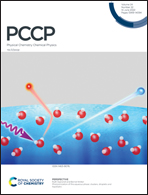The photoluminescence of isolated and paired Bi3+ ions in layered LnOCl crystals: a first-principles study†
Abstract
Luminescent ns2 centers have shown great potential for applications as phosphors and scintillators. First-principles calculations based on density functional theory are performed to systematically analyze the luminescent centers of isolated and paired Bi3+(6s2) ions in layered LnOCl (Ln = Y, Gd, La) crystals. The spin–orbit coupling and orbital hybridization both show important effects on the luminescence properties. The luminescence of the isolated Bi ion is confirmed as the interconfigurational transition of 3P0,1 → 1S0. For the Bi pair, the adiabatic potential energy surfaces are calculated and the charge transfer excited state is the most stable, which accounts for the visible emission of a large Stokes shift. Furthermore, the electron–hole pair separation, absorption, excitonic state and emission of the material with fully-concentrated Bi3+, BiOCl, are discussed. This study shows that the first-principles calculations can serve as an effective tool for the photoluminescence analysis and engineering of materials activated with isolated, paired and even fully-concentrated ns2 ions.



 Please wait while we load your content...
Please wait while we load your content...